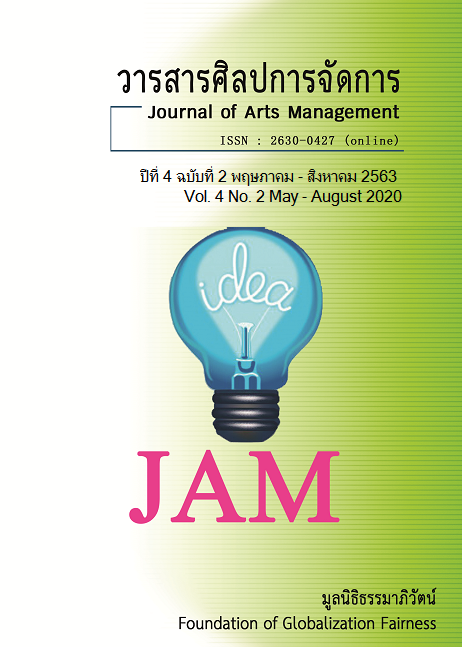The Causal Relationship Model of Behavioral Intention of Priestly Buddhism Goods through Lazada Application of Customers in Bangkok and Vicinity
Main Article Content
Abstract
Abstract
The objectives of this research were to develop a causal of relationship modal of behavioral intention of priestly buddhism goods through Lazada application of customer in Bangkok and Vicinity and to validate the consistency of the causal relationship model with empirical data. The tools used in the research was online questionnaires. The sample group consisted of 400 peoples who have been bought priestly buddhism goods through Lazada application. The statistics used in data analysis was the structural equation model is used to analyze causal relationships to find the path to the causal influence of the variables consisting of 4 components are 1) Perceived Usefulness 2) Perceived Ease of Use 3) Attitude Towards Priestly Buddhism Goods and
4) Behavioral Intention.
The results of the research showed that the causal relationship model was developed in accordance with empirical data. The final is predictive coefficient of 0.92, indicating that the variables in the model can explain the variance of the Behavioral Intention of Priestly buddhism goods through Lazada application by 92 percent. It was found that the Attitude towards Priestly Buddhism Goods were the most influence on Behavioral Intention of priestly Buddhism goods through Lazada application of customer in Bangkok and Vicinity.
Article Details
Views and opinions appearing in articles in the Journal of Arts of Management It is the responsibility of the author of the article. and does not constitute the view and responsibility of the editorial team I agree that the article is copyright of the Arts and Management Journal.
References
กริช แรงสูงเนิน. (2554). การวิเคราะห์ปัจจัยด้วย SPSS และ AMOS เพื่อการวิจัย. กรุงเทพฯ: ซีเอ็ดยูเคชั่น.
ชาญชัย อรรถผาติ. (2557). ปัจจัยที่ส่งผลต่อทัศนคติในการยอมรับในเทคโนโลยีคลาวด์คอมพิวติ้งเพื่อประยุกต์ใช้ในการให้บริการระบบบัญชีออนไลน์สำหรับวิสาหกิจขนาดกลางและขนาดย่อมในมุมมองของผู้ทำบัญชี(วิทยานิพนธ์ปริญญาบัญชีมหาบัณฑิต). มหาวิทยาลัยธุรกิจบัณฑิตย์.
ธานินทร์ ศิลป์จารุ. (2560). การวิจัยและวิเคราะห์ข้อมูลทางสถิติด้วย SPSS และ AMOS. (พิมพ์ครั้งที่ 17). กรุงเทพฯ: บิสซิเนส อาร์แอนด์ดี.
นงลักษณ์ วิรัชชัย. (2542). โมเดลลิสเรล: สถิติวิเคราะห์สำหรับการวิจัย. (พิมพ์ครั้งที่ 3). กรุงเทพฯ:
โรงพิมพ์แห่งจุฬาลงกรณ์มหาวิทยาลัย.
พระมหานุกูล เสกประโคน. (2558). รูปแบบการตลาดของธุรกิจสังฆภัณฑ์ในเขตกรุงเทพมหานคร. วารสารวิชาการ มหาวิทยาลัยราชภัฏพระนคร, 6(2), 77-88.
เมษา วัฒนพิชัย. (2558). ความสัมพันธ์ระหว่างทัศนคติและความตั้งใจซื้อของผู้บริโภคต่อการสื่อสารและการตลาดของร้านค้าสินค้าแฟชั่นออนไลน์ที่ไม่มีหน้าร้าน(วิทยานิพนธ์นิเทศศาสตรมหาบัณฑิต). จุฬาลงกรณ์มหาวิทยาลัย.
วิภาเพ็ญ เล้าประเสริฐ. (2558). กลยุทธ์การเพิ่มยอดขายร้านสกุลเพชรสังฆภัณฑ์ในอำเภอภูเวียง จังหวัดขอนแก่น(การศึกษาอิสระปริญญาบริหารธุรกิจมหาบัณฑิต). มหาวิทยาลัยขอนแก่น.
สยามโฟน. (2562). LAZADA ย้ำแชมป์อีคอมเมิร์ซอันดับหนึ่งในไทย ติดโผอันดับ 4 แบรนด์ที่ถูกพูดถึง
มากที่สุดในประเทศ. สืบค้นเมื่อวันที่ 1 พฤศจิกายน 2562. จาก https://news.siamphone.com
สุนิฏฐา ภู่พงศ์พันธ์. (2555). ทัศนคติและความตั้งใจซื้อคูปองส่วนลดค่าสินค้าและบริการผ่านเว็บไซต์พาณิชยกรรมทางสังคมออนไลน์ของผู้บริโภคในเขตกรุงเทพมหานคร(การศึกษาค้นคว้าอิสระปริญญาบริหารธุรกิจมหาบัณฑิต สาขาวิชาการตลาด). มหาวิทยาลัยศรีนครินทรวิโรฒ.
Bauerova, R. & Klepek, M. (2018). Technology Acceptance as a Determinant of Online Grocery Shopping Adoption. Acta Universitatis Agriculturae Et Silviculturae Mendelianae Brunensis, 66(3), 737-746.
Davis, F. D. (1989). Perceived usefulness, perceived ease of use, and user acceptance of Information technology. MIS Quarterly, 13(3), 318-339.
Fishbein, M., & Ajzen, I. (1975). Belief, attitude, intention, and behavior: An introduction to theory and research. Reading, MA: Addison-Wesley.
Zeithaml, V. A., Parasuraman, & L. L., Berry. (1990). Delivering Quality Service: Balancing Customer Perceptions. New York: The Free Press.


